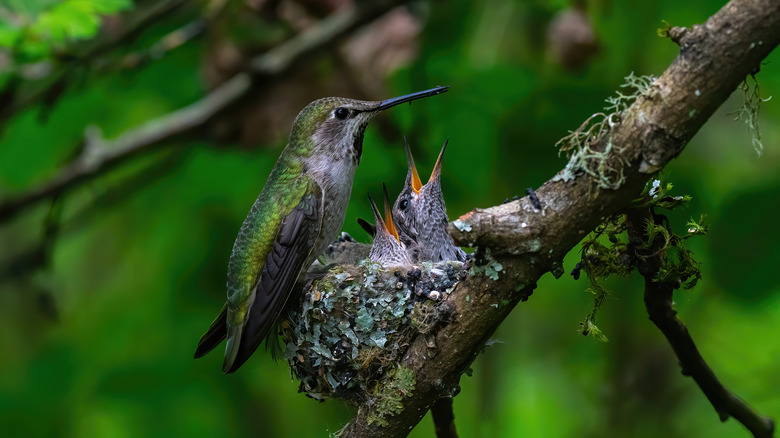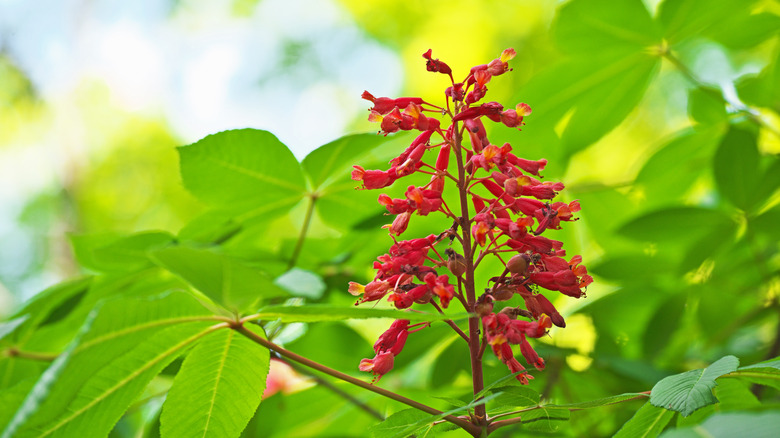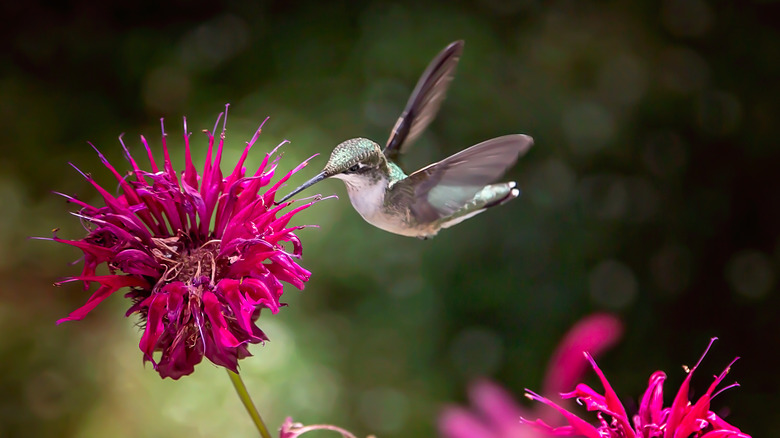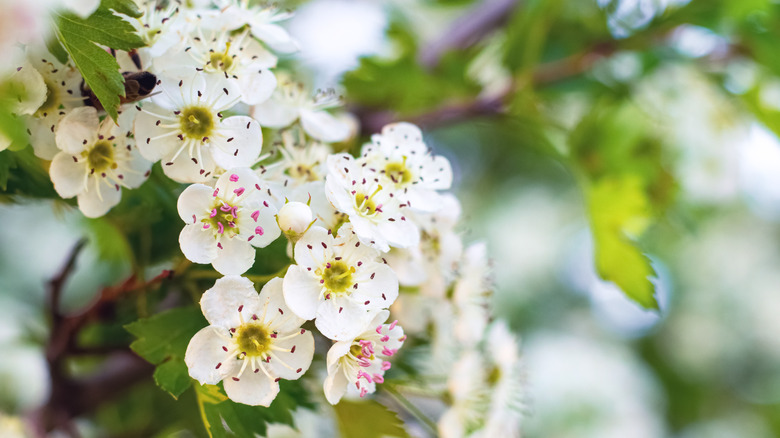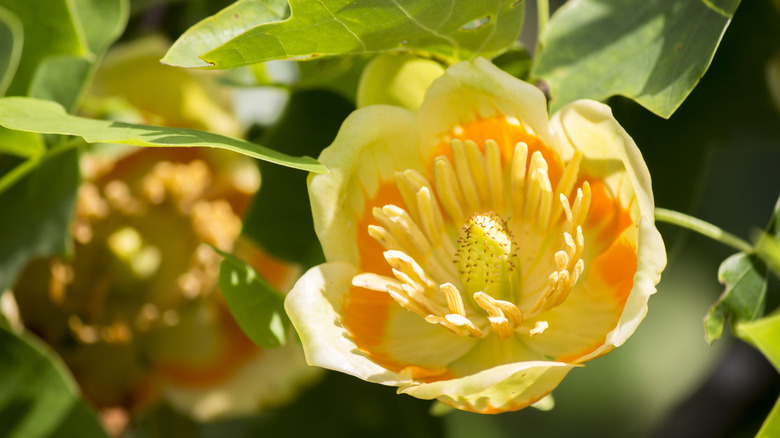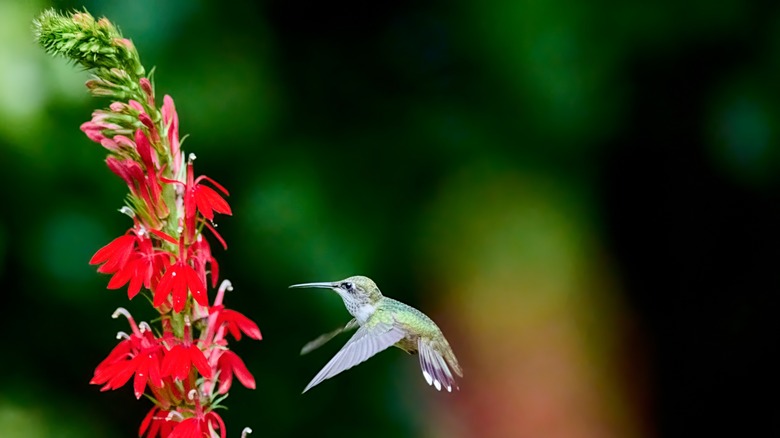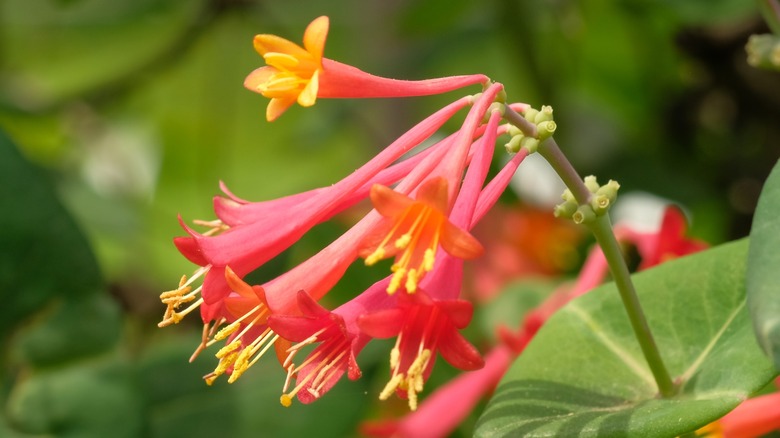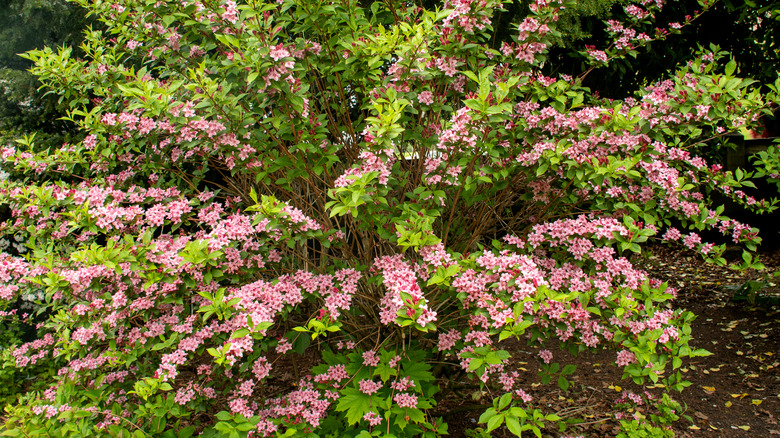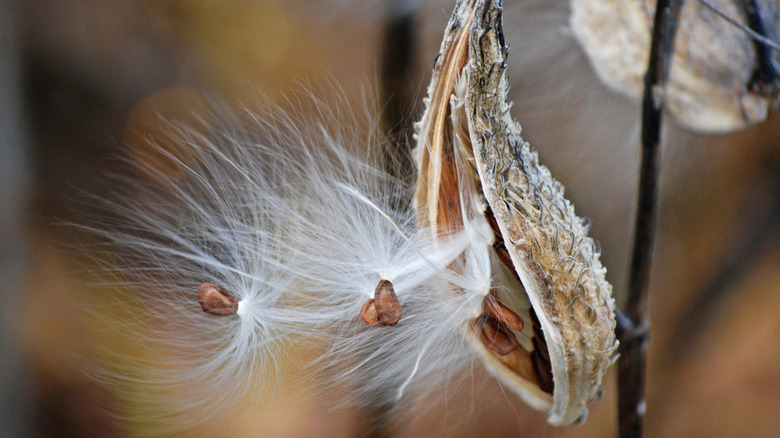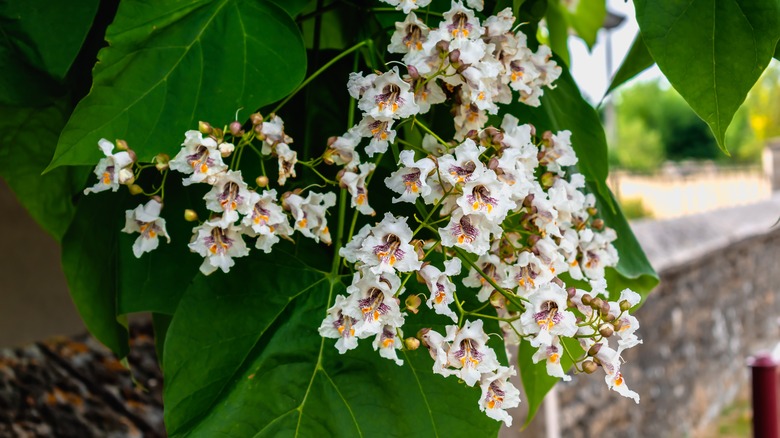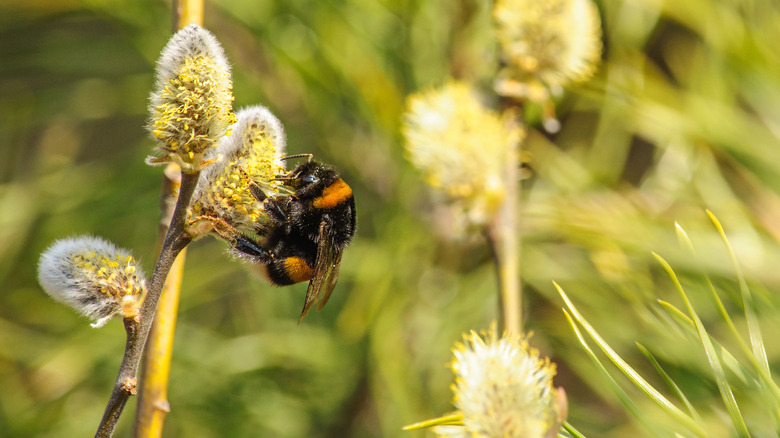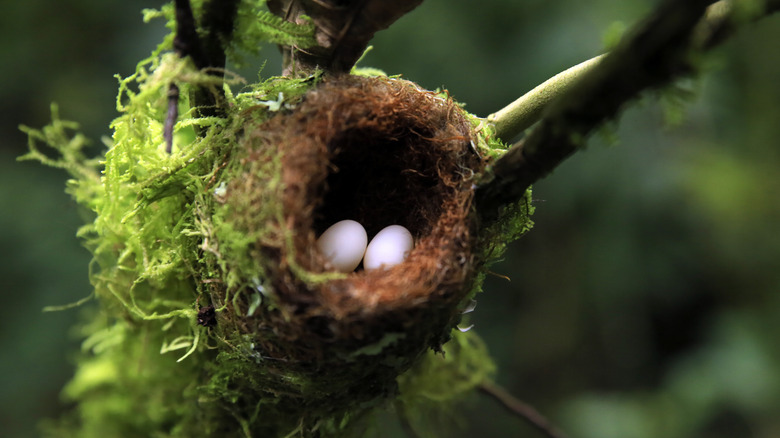Hummingbirds Will Flock To These Nest-Building Plants In Your Garden
Hummingbirds are like the chihuahuas of the bird world: they are tiny, territorial, tightly wound, and too cute. While there are 17 species that nest in the United States, most live near the border where temperatures are higher. Anyone on the East Coast sadly only has the ruby-throated hummingbird to enjoy. Still, just one in the garden is enough to spark joy in our hearts. So, it's an honor to convince them to set up shop and lay some of the tiniest eggs to exist in the bird world.
If you're going to convince them to stay though, you have to make it worth their while. It's hard work being a hummingbird. Their wings beat around 70 times per second while flying normally, and they have a resting heart rate of 225 beats per minute. So, when they want to build a nest, they look for convenient building materials, water, and food. This list of plants can help you attract them, but you should check whether a plant is invasive before growing it.
Create a one-stop shop with a red buckeye
The bright scarlet-colored, tubular flowers of the red buckeye, or Aesculus pavia, are like a neon "open" sign for hungry hummingbirds. The voracious birds need to eat half of their body weight every day. So, they embody that eat, sleep, repeat lifestyle. As you can imagine, these pint-sized birds are also on the menu for many predators, so the bonus of foliage to hide in is a serious plus.
The red buckeye can be in the form of a tree or a shrub that grows to be between fifteen and twenty-five feet tall and likes moist, partially shaded spots. In the spring, six to eight-inch-long clusters of flowers bloom for about a month. While hummingbirds love the convenience of delicious food and rest, it should be known that humans cannot eat any part of this plant. It is poisonous, so please consider this if you have curious children.
Offer them a type of native monarda
When it comes to attracting native pollinators to your yard, providing native plants as food is always a solid start. The two varieties of monarda that are native to several states on the East Coast and Midwest are Monarda didyma and Monarda fistulosa. You may have also heard people refer to them as beebalm, a reference to the use of the plant's resin to soothe bee stings.
Monarda didyma is a striking red, with a well-earned nickname of scarlet or crimson beebalm. They get about two to three feet tall with an array of 1.5-inch long flowers that kind of look like an alien spacecraft. Their more subtle counterpart is often called wild bergamot and will grow to be two to four feet tall. Whether you choose the light purple or bright red, hummingbirds love the nectar from these funky-looking blooms in the summer.
Plant a hawthorn to nest in
While food, water, and nesting materials are all important, a hummingbird needs a place to safely build the nest before it will decide to stay. The hawthorn tree is an all-around excellent native tree that not only provides tasty flowers but also a branch to call home. Hawthorn is the common name for several species of trees in the Crataegus genus that range in habitat through most of the East Coast to the Midwest. Because there are so many types for you to choose from, you can find one that best suits your yard, especially in terms of size.
All hawthorns do have clusters of white flowers that hummingbirds enjoy in the spring. Because they often build their nests on small branches, they will enjoy the food right on their doorstep while they can. And, the birds' opinions aside, these trees have beautiful fall colors for you to enjoy from your own doorstep!
Give them plenty of nesting space with a poplar
For a gorgeous tree that will have hummingbirds flocking to your yard, consider planting a yellow poplar. Liriodendron tulipifera, also known as a tulip tree, is a big tree with a full-grown range of 60-90 feet tall and 30-50 feet wide. Similar to the hawthorn tree above, yellow poplars make safe nesting sites for the little birds because of their height and leaf cover. With so much room to choose from, they may even make more than one nest in a year.
Because they can't reuse their nests, they may start building a second nest nearby while still feeding the babies in the first one. Providing such a large tree can make her search just a little easier on her, and you could get twice the baby birds. It's just an added bonus that the cup-shaped, yellow blooms are tempting sources of nectar for them.
Attract them to dinner with the brilliant cardinal flower
Did you know that hummingbirds have a favorite color? At least when it comes to their dining locations, they gravitate to red flowers like spaghetti sauce to a clean, white shirt. In the case of Lobelia cardinalis, or cardinal flower, hummingbirds are the main pollinator. Their long beaks and tongues are designed for getting to the nectar at the base of the tubes.
These tall spikes of color can be found in at least 42 states, so you may be able to find them online or at your local nursery. You may even spot them in a ditch, ravine, roadside, or one of the many natural spots they pop up in. Because they can handle sun, part-shade, and shade, they can be found in a lot of very different habitats. However, they have become scarce in some areas around the country due to over picking by humans. So, adding some to your garden can be a delightful find for your local hummingbirds.
Plant a native honeysuckle vine
The term "honeysuckle" inspires an immediate gasp and a whispered "invasive" in the minds of worried gardeners, but not every species is. Specifically, Lonicera sempervirens is native in many states. Once you can tell if your honeysuckle is native or invasive, you are well on your way to supplying hummingbirds with another delicious food choice. The common themes for favorite flowers are the tube shape and the red color, both of which this native honeysuckle vine has.
Also known as trumpet honeysuckle, the vines can reach up to twenty feet tall and six feet wide. Like most soft vining plants, they need a structure like a trellis or arbor to cling onto. The thick group of intertwining stems will then become an excellent perch to take a rest on. Or, the hummingbirds may take cover in the shade of the honeysuckle's leaves between meals. They might even build their nest inside of the vines if there is a stable enough structure to keep it safe. All around, Lonicera sempervirens is a solid investment.
Add blooms and branches to the menu with weigela florida
As great as installing a 90-foot yellow poplar might feel, that's a lot of space in an urban backyard. The Weigela florida is a beautiful, non-invasive shrub that will be helpful to gardeners who cannot plant a new tree for hummingbirds. This flowering shrub can get as tall as 10 feet and as wide as 12 feet, so it isn't exactly tiny. Still, it can provide a woody perch and foliage shelter to hummingbirds between meals while tucked into the corner of your yard.
The flowers are the real attractive feature of Weigela florida though. Blooming in the spring on old wood, the long, whip-like branches are covered in flowers between the leaves. Hummingbirds like to hide from predators between drinks, especially when they are out in the open for predatory birds to find them. They also don't drink nectar exclusively. They also like small insects like fruit flies, so it's helpful to plant things that attract insects too, like this ornamental shrub.
Provide nest fluff with milkweed
Monarch butterflies aren't the only pollinators that milkweed is good for. While the flowers are not especially attractive to hummingbirds, the seed pods are a gold mine. Several members of the asclepias genus produce three to six-inch long seed pods that burst open along a seam when the seeds are ready. Each flat seed is connected to a tuft of fluff called a pappus that allows it to be spread by the wind. That is unless a hummingbird steals it to cushion its walnut-sized nest!
Swamp milkweed, Asclepias incarnata, is one of the typical species carried in many nurseries, so it may be easier to find than the more specialty kinds. Whenever possible, growing native is the best course of action, but ruby-throated hummingbirds live all over the Eastern United States. They can adapt to whatever you have, as long as it attracts small insects and produces seed pods. However, they may prefer butterfly weed's orange flowers.
Provide food and shelter with a catalpa tree
As we mentioned before, the flowering tree combo is a big attractor to hummingbirds. With safety, food, and a solid post to nest on, they are more likely to set up shop and come back after migration. In the case of Catalpa speciosa, hummingbirds love this fast-growing tree. The delicate white and yellow flowers are clustered together, making it easier on the fast-moving bird. It also has almost comically big leaves that can easily shelter a hiding feathered friend.
However, some caution is advised while considering this tree for your yard. While it grows natively in Tennessee, Arkansas, Missouri, and parts of Indiana and Illinois, it can have invasive tendencies in other places. The seedpods can also be a downside for homeowners who aren't fans of scrubbing their sidewalks or raking them out of their lawns. The pods look like giant green beans in their shape but turn a dark brown before falling.
Offer nesting material and perching spots
These little birds are also quite creative when it comes to building their nests. They utilize soft, flexible ingredients like plant fluff, grass, and bud coverings to make little beds about the size of a walnut. Varieties of willow, a member of the Salix genus, are well-known for their soft flower buds named after cat paws, but their bud scales are easy to forget about. The shiny shell falls off the whip-like stems just before the willow's flowers bloom, but with hummingbirds around, they don't all go to waste. Just make sure you have the male willow if you specifically want the fuzzy buds.
Unlike the rest of the woody plants on this list, these blooms aren't appealing to the little birds. There are no petals or nectar for them to eat. However, if there are fruit flies to snack on while they are shopping for their nests, well, that's just a bonus.
Let them camouflage their nests with moss
With the adorable image of hummingbirds building a nest out of little pieces of plants and twigs fresh in mind, get ready for even more cute nest-building facts. It takes about seven days to finish up, and while the base can be things like scales and leaves, the birds take great pains to make their nests soft and hidden. While the fluff from milkweed and willows make a nice cushion, lichen and moss are also used in the process. The moss is used for camouflage to help the nest blend in with the tree bark it is built on.
But allowing and even planting moss in the shady parts of your garden are great for hummingbirds to fly down and snag some pieces. It's also an excellent ground cover, especially between pavers. Irish moss, a.k.a. Sagina subulata, only grows to one or two inches tall, so you don't have to mow it. It does prefer regular watering to keep it green.
